
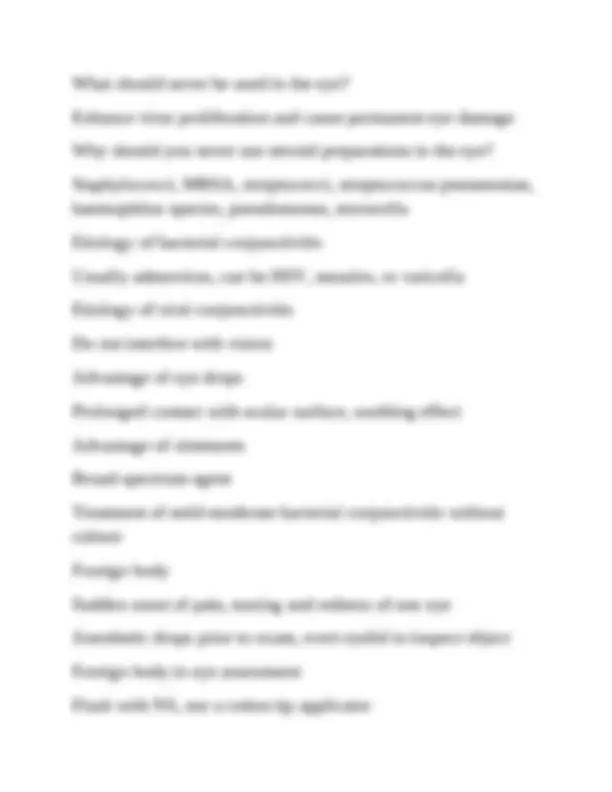
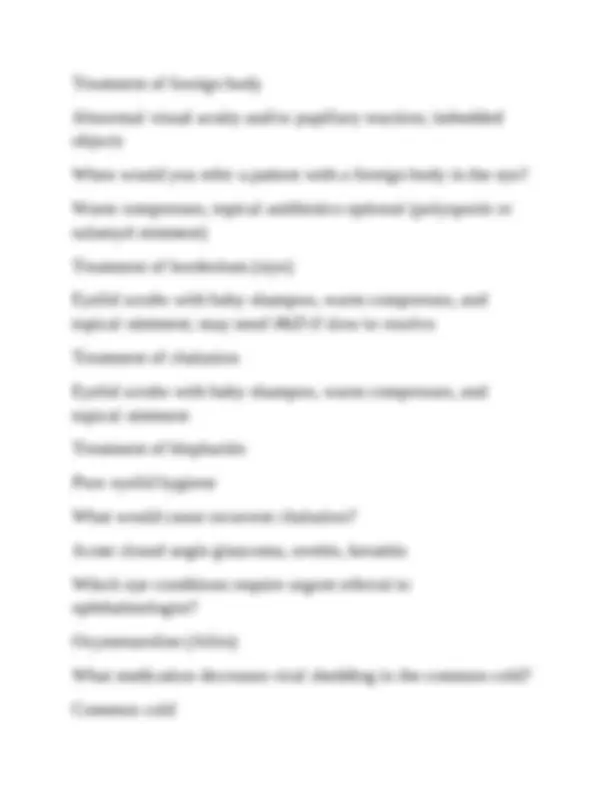
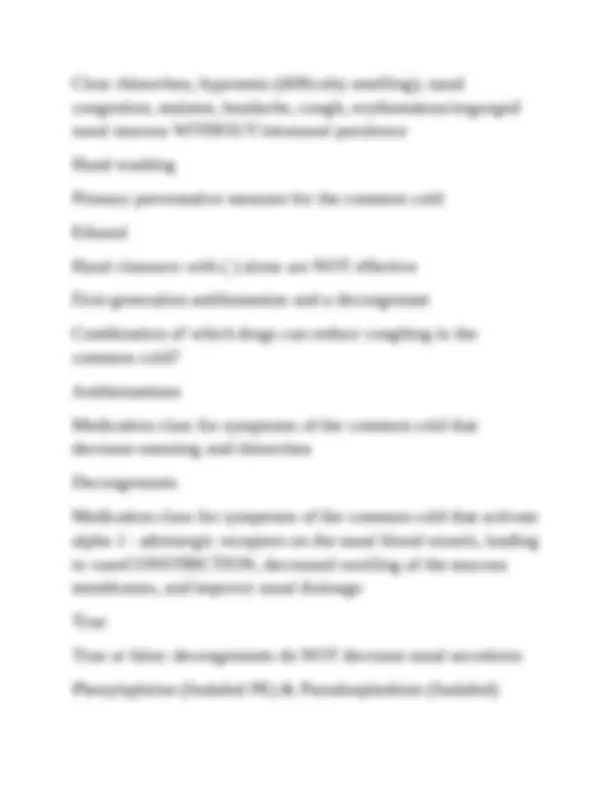
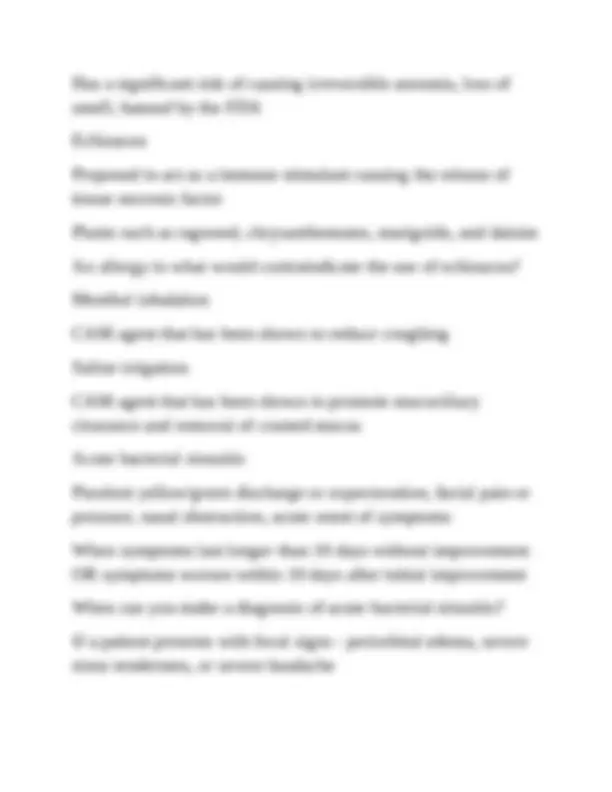
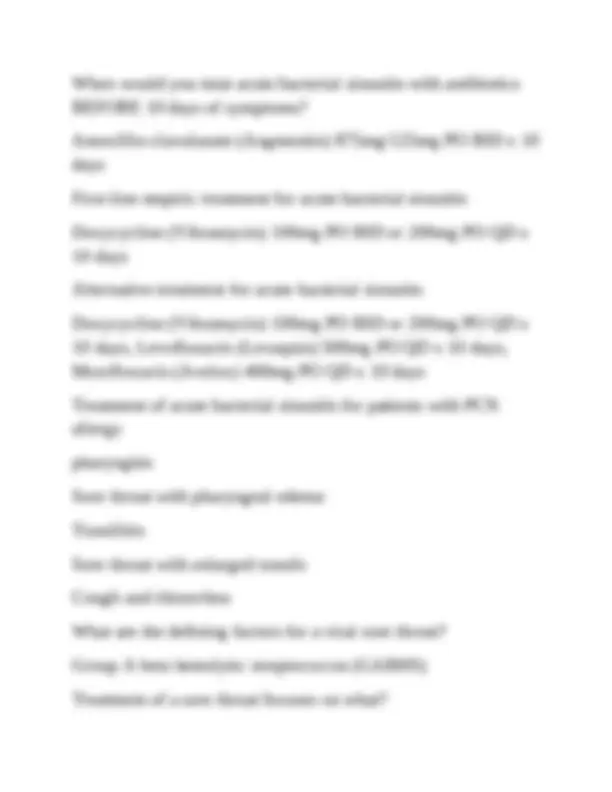
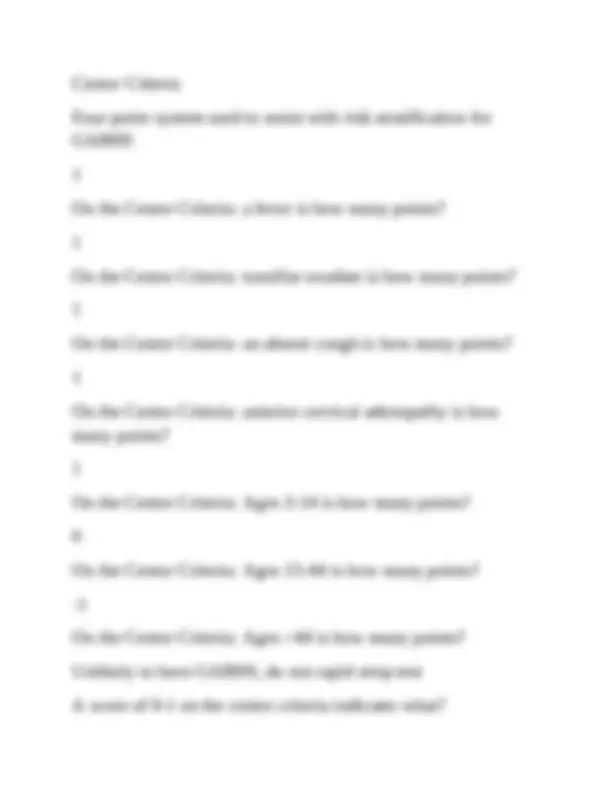
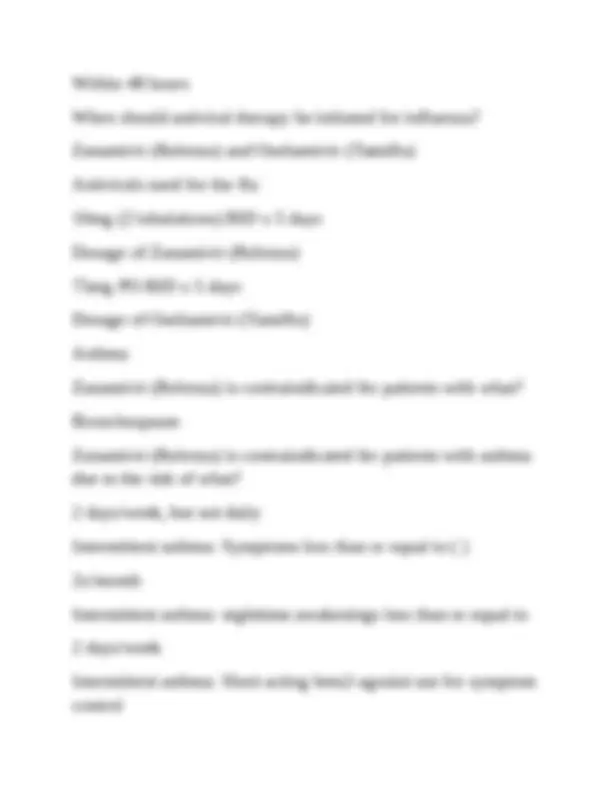
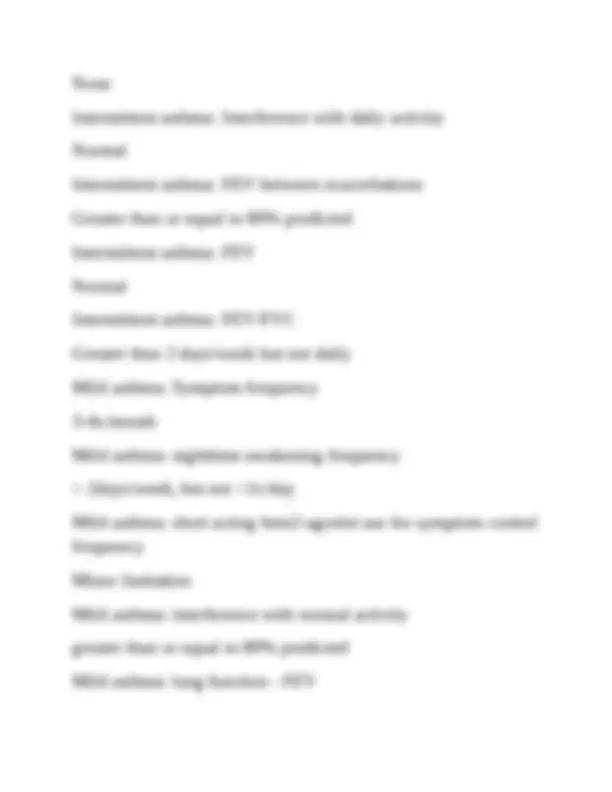
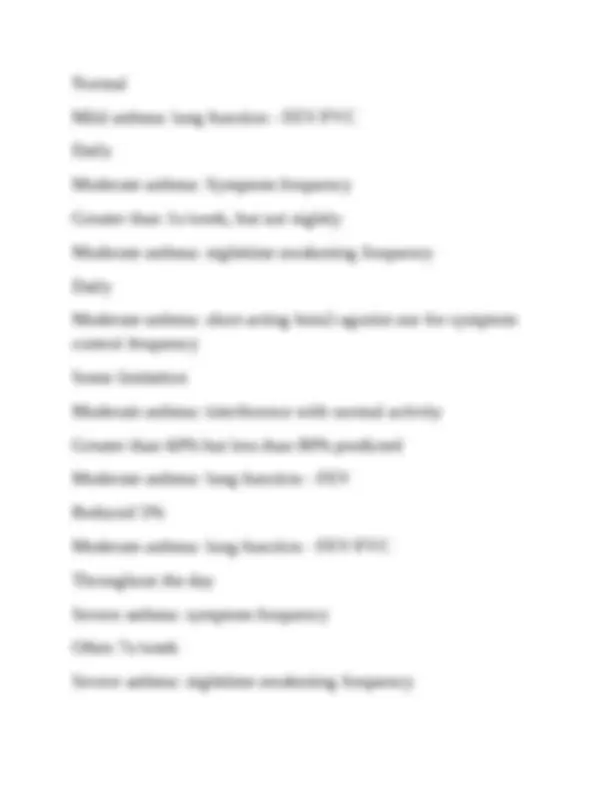
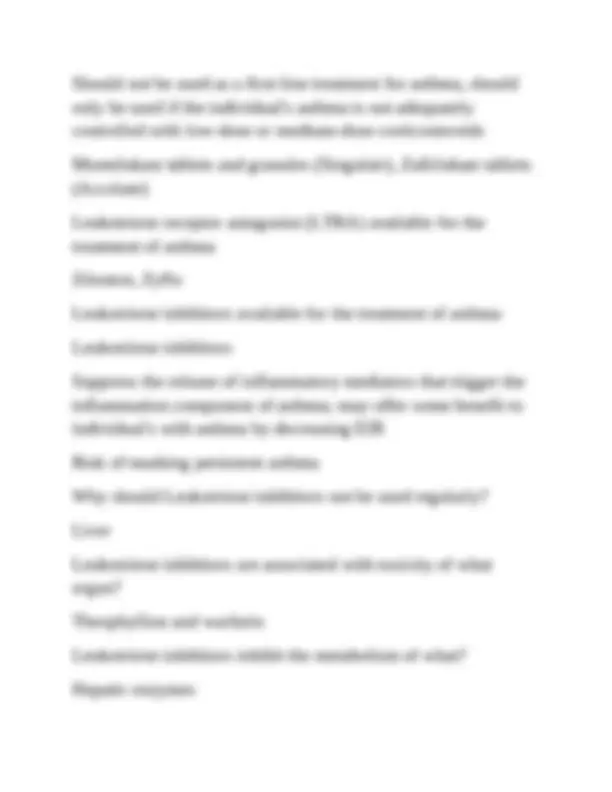
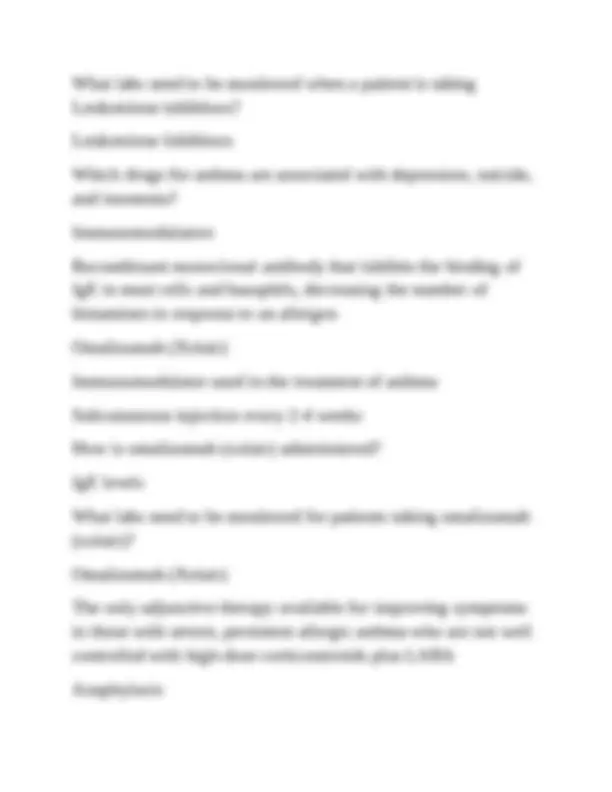
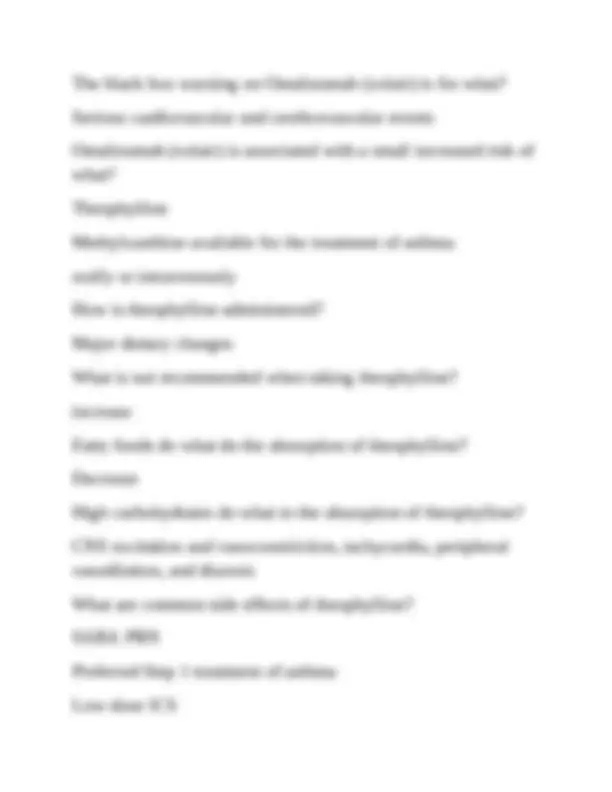
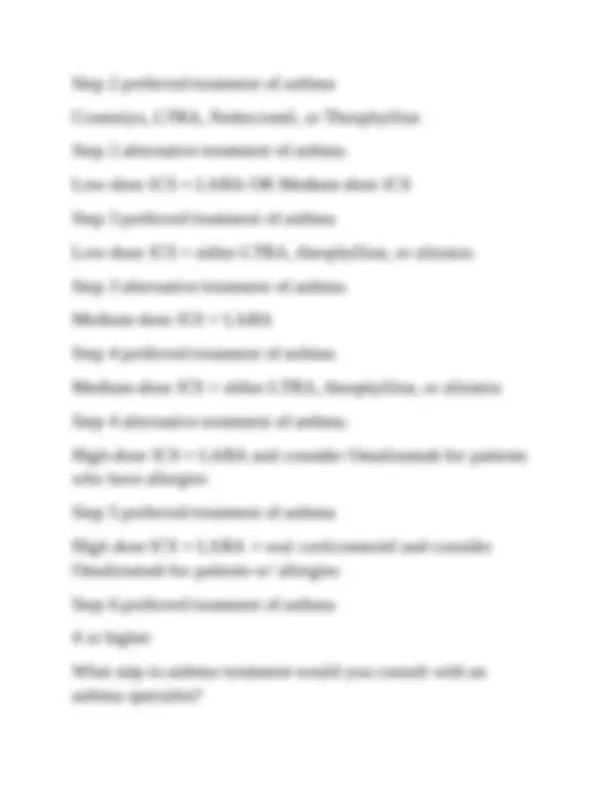
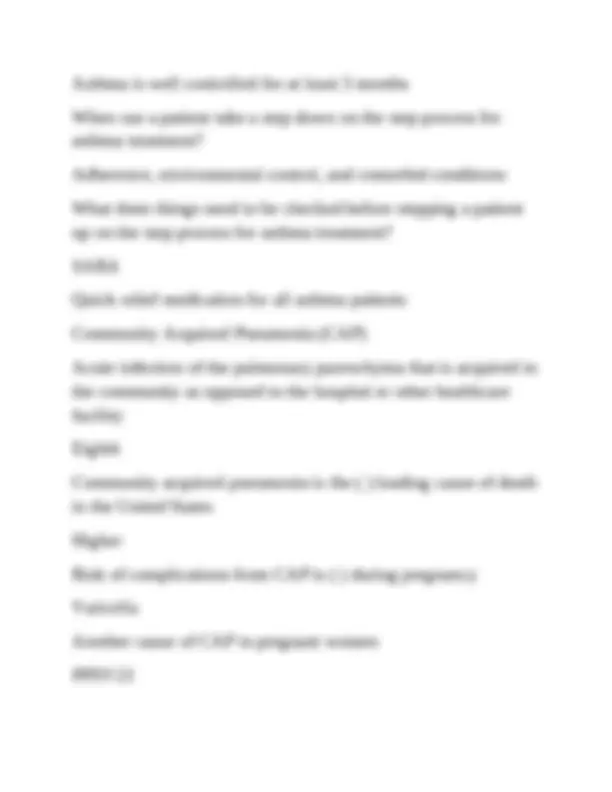
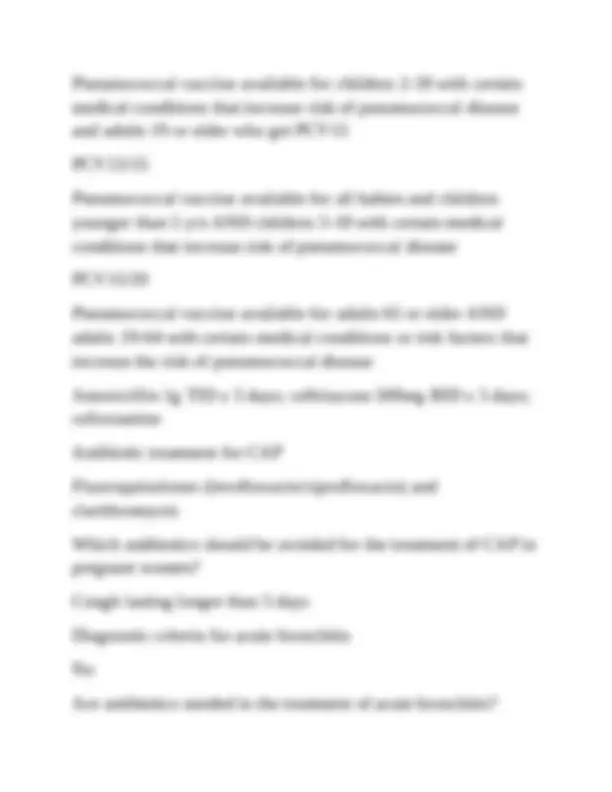
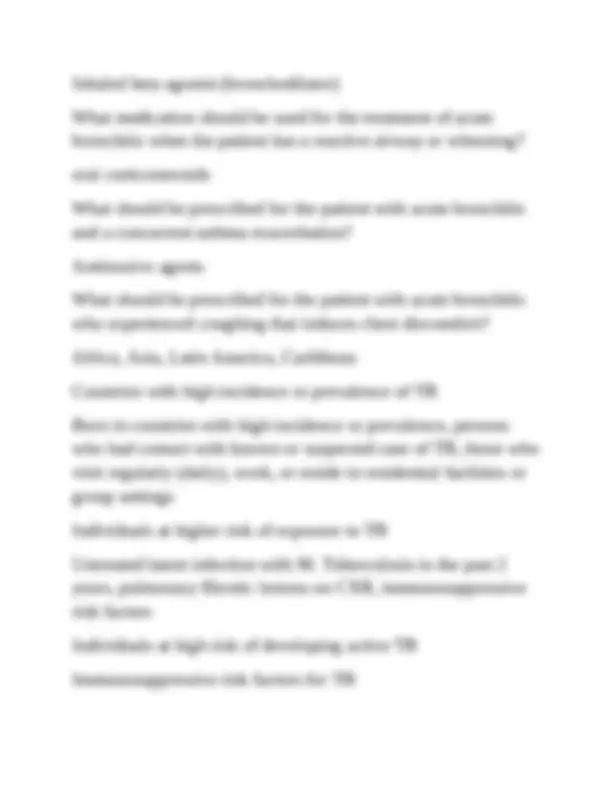
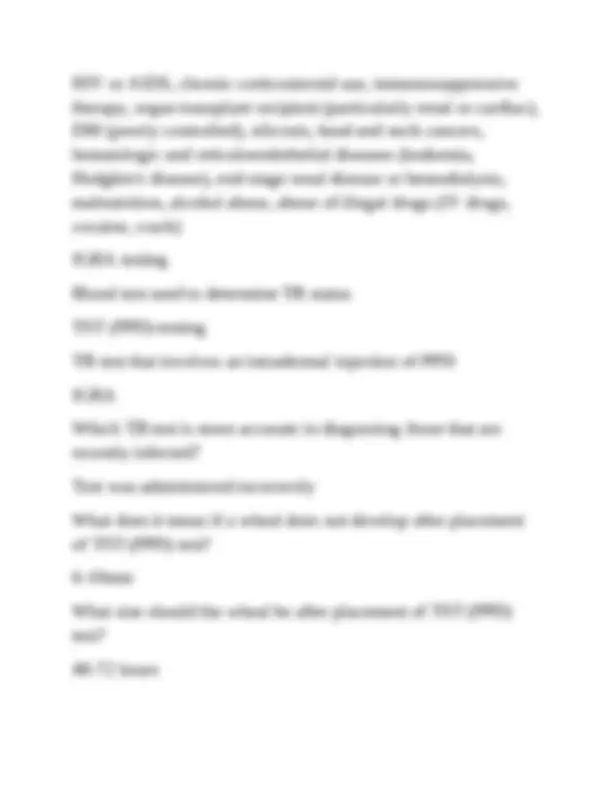
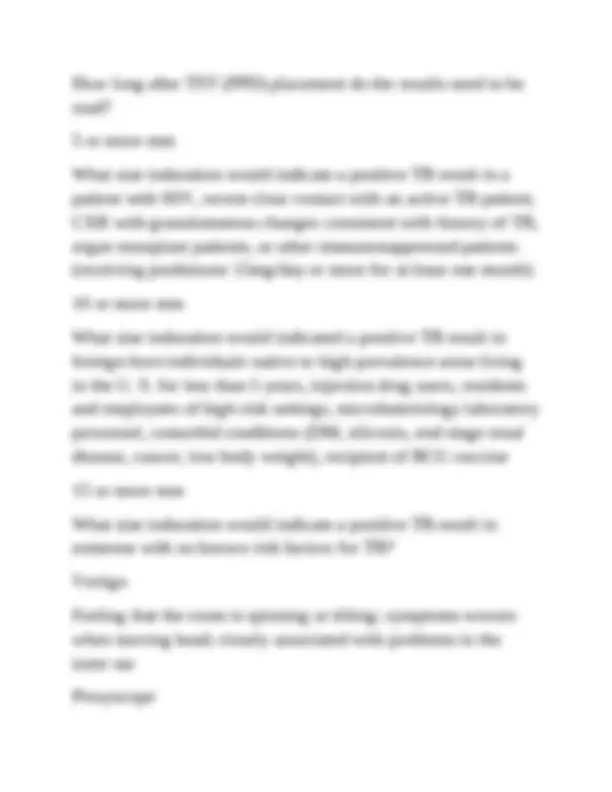
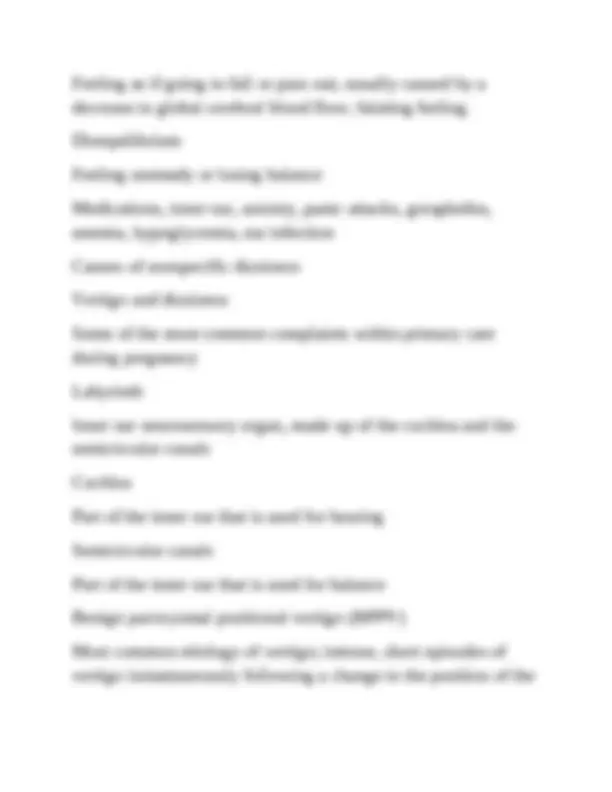
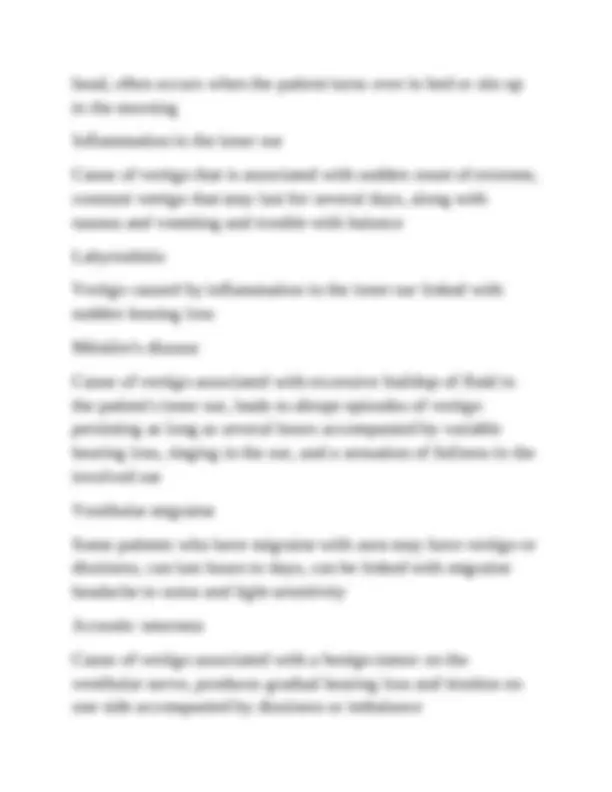
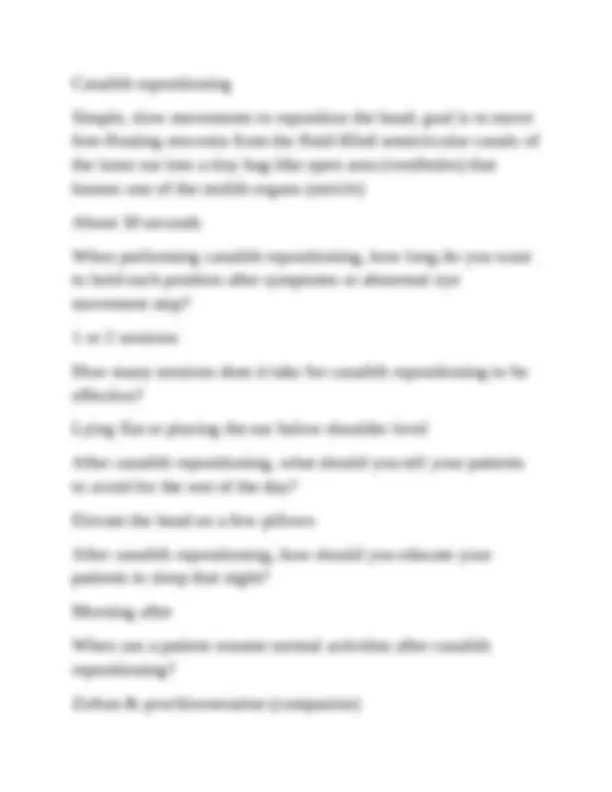
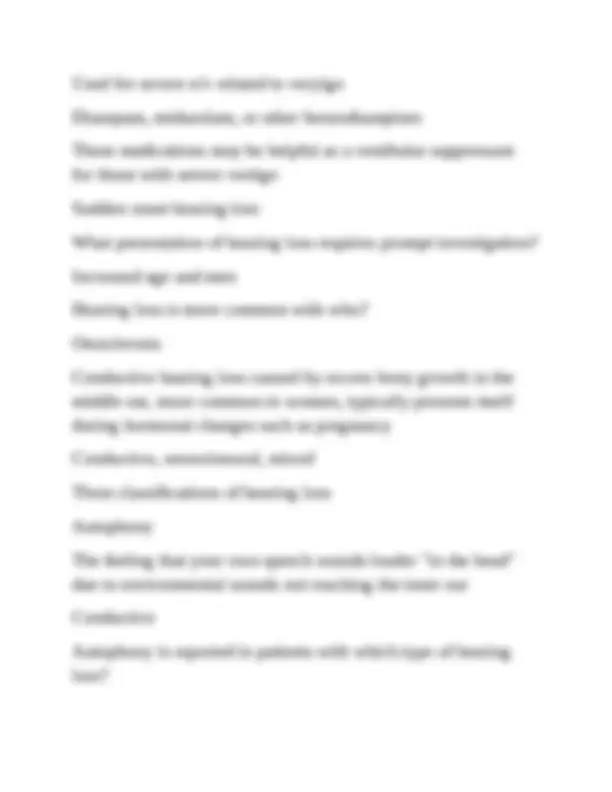
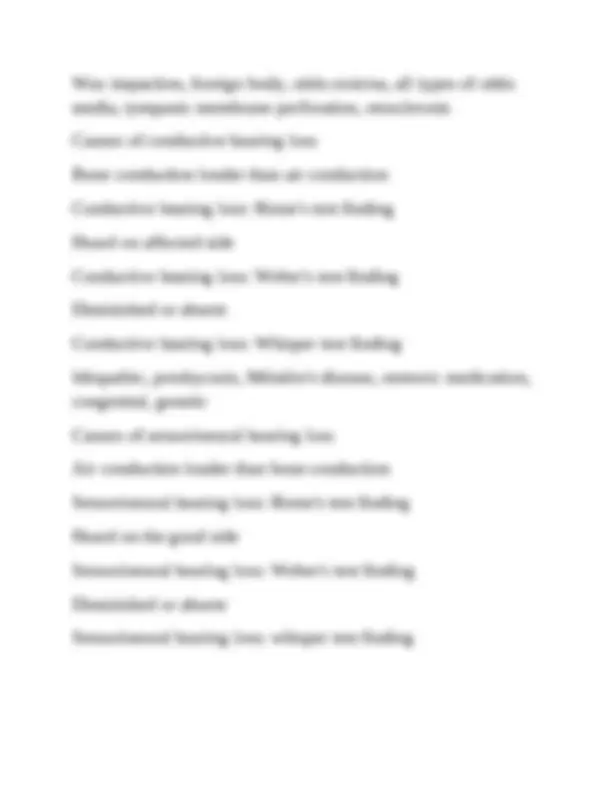


Study with the several resources on Docsity

Earn points by helping other students or get them with a premium plan


Prepare for your exams
Study with the several resources on Docsity

Earn points to download
Earn points by helping other students or get them with a premium plan
Community
Ask the community for help and clear up your study doubts
Discover the best universities in your country according to Docsity users
Free resources
Download our free guides on studying techniques, anxiety management strategies, and thesis advice from Docsity tutors
A comprehensive set of questions and answers related to various eye conditions, including conjunctivitis, corneal abrasion, hordeolum, chalazion, and blepharitis. It also covers common cold symptoms, treatment options, and preventative measures. Additionally, the document delves into acute bacterial sinusitis, pharyngitis, tonsillitis, and influenza, providing information on diagnosis, treatment, and management strategies. Valuable for students studying medicine or related fields, offering a structured approach to understanding these conditions and their associated treatments.
Typology: Exams
1 / 31

This page cannot be seen from the preview
Don't miss anything!
























MCN542- Exam 2 Questions With Complete Solutions Conjunctivitis (pink eye) Most common condition in patients who present with red eyes; an inflammation of the conjunctiva (mucous membrane that lines, the inner surface of the eyelid and surrounding tissue) Bacterial conjunctivitis Redness, PURULENT drainage, eyes matted in the morning Viral conjunctivitis Redness in one or both eyes, CLEAR WATERY discharge, PREAURICULAR LYMPH NODES often swollen Allergic Conjunctivitis Itchy, Watery, red eyes; other allergy symptoms; discharge is white and stringy Corneal abrasion Sudden, severe, unilateral, eye pain, tearing, redness; the use of fluorescein dye and Woods or Cobalt Blue lamp, will cause this to appear as bright yellow/green hordeolum (stye) Tender, red, warm, papule on eyelid Localized infection in the glands of Zeis, usually staphylococcus
Cause of a hordeolum (stye) Chalazion Eyelid nodule with localized redness Obstruction of meibomian gland Causes of a chalazion Blepharitis Redness and irritation of eyelid margins, may be accompanied by dry eye symptoms and conjunctivitis Acute closed angle glaucoma Rapid onset of severe unilateral eye, pain, vision with halos around lights; may be accompanied by nausea and abdominal pain; cloudy appearing cornea, dilated nonreactive pupil, eyelid feels hard on palpation Uveitis Unilateral eye pain, photophobia, may have blurred vision, perilimal erythema, cornea may be cloudy, pupil usually small but reactive Keratitis Complication of contact lens use; painful red eye, reduced visual acuity, eyelid swelling, photophobia Steroid preparations
Treatment of foreign body Abnormal visual acuity and/or pupillary reaction; imbedded objects When would you refer a patient with a foreign body in the eye? Warm compresses, topical antibiotics optional (polysporin or sulamyd ointment) Treatment of hordeolum (stye) Eyelid scrubs with baby shampoo, warm compresses, and topical ointment; may need I&D if slow to resolve Treatment of chalazion Eyelid scrubs with baby shampoo, warm compresses, and topical ointment Treatment of blepharitis Poor eyelid hygiene What would cause recurrent chalazion? Acute closed angle glaucoma, uveitis, keratitis Which eye conditions require urgent referral to ophthalmologist? Oxymetazoline (Afrin) What medication decreases viral shedding in the common cold? Common cold
Clear rhinorrhea, hyposmia (difficulty smelling), nasal congestion, malaise, headache, cough, erythematous/engorged nasal mucosa WITHOUT intranasal purulence Hand washing Primary preventative measure for the common cold Ethanol Hand cleansers with ( ) alone are NOT effective First-generation antihistamine and a decongestant Combination of which drugs can reduce coughing in the common cold? Antihistamines Medication class for symptoms of the common cold that decrease sneezing and rhinorrhea Decongestants Medication class for symptoms of the common cold that activate alpha 1 - adrenergic receptors on the nasal blood vessels, leading to vasoCONSTRICTION, decreased swelling of the mucous membranes, and improve nasal drainage True True or false: decongestants do NOT decrease nasal secretions Phenylephrine (Sudafed PE) & Pseudoephedrine (Sudafed)
True or false: nasal corticosteroids offer no relief of nasal congestion associated with the common cold Intranasal ipratropium (atrovent) Anticholinergic agent that is effective in decreasing the symptoms of a cough be inhibiting vagally mediated reflexes True True or false: intranasal ipratropium (atrovent) is safe to use during pregnancy and/or breastfeeding Nasal dryness or epistaxis Adverse reactions of intranasal ipratropium (atrovent) Postnasal drip Most common etiology of the cough that accompanies the common cold Ibuprofen Superior analgesic for fever control Antitussive cough suppressant Expectorants/Mucolytics Assist in clearing the lungs of mucus Intranasal zinc
Has a significant risk of causing irreversible anosmia, loss of smell; banned by the FDA Echinacea Proposed to act as a immune stimulant causing the release of tissue necrosis factor Plants such as ragweed, chrysanthemums, marigolds, and daisies An allergy to what would contraindicate the use of echinacea? Menthol inhalation CAM agent that has been shown to reduce coughing Saline irrigation CAM agent that has been shown to promote mucociliary clearance and removal of crusted mucus Acute bacterial sinusitis Purulent yellow/green discharge or expectoration, facial pain or pressure, nasal obstruction, acute onset of symptoms When symptoms last longer than 10 days without improvement OR symptoms worsen within 10 days after initial improvement When can you make a diagnosis of acute bacterial sinusitis? If a patient presents with focal signs - periorbital edema, severe sinus tenderness, or severe headache
Centor Criteria Four-point system used to assist with risk stratification for GABHS 1 On the Centor Criteria: a fever is how many points? 1 On the Centor Criteria: tonsillar exudate is how many points? 1 On the Centor Criteria: an absent cough is how many points? 1 On the Centor Criteria: anterior cervical adenopathy is how many points? 1 On the Centor Criteria: Ages 3-14 is how many points? 0 On the Centor Criteria: Ages 15-44 is how many points?
On the Centor Criteria: Ages >44 is how many points? Unlikely to have GABHS, do not rapid strep test A score of 0-1 on the centor criteria indicates what?
Should have rapid strep test A score of 2 or more on the centor criteria indicates what? Can be treated without rapid strep testing Adults with a score of 3 or more on the centor criteria Oral Pen V or amoxicillin Antibiotic of choice for bacterial tonsillitis/pharyngitis Pen G IM Antibiotic of choice for bacterial tonsillitis/pharyngitis for patients with compliance issues Erythromycin/azithromycin Antibiotic of choice for bacterial tonsillitis/pharyngitis for patients with PCN allergy Influenza Upper respiratory infection with fever, chills, cough, sore throat, runny/stuffy nose, muscle/body aches, headaches, fatigue, vomiting/diarrhea (common in children) A Most common and virulent strain of influenza B Strain of influenza associate with Reye Syndrome
Within 48 hours When should antiviral therapy be initiated for influenza? Zanamivir (Relenza) and Oseltamivir (Tamiflu) Antivirals used for the flu 10mg (2 inhalations) BID x 5 days Dosage of Zanamivir (Relenza) 75mg PO BID x 5 days Dosage of Oseltamivir (Tamiflu) Asthma Zanamivir (Relenza) is contraindicated for patients with what? Bronchospasm Zanamivir (Relenza) is contraindicated for patients with asthma due to the risk of what? 2 days/week, but not daily Intermittent asthma: Symptoms less than or equal to ( ) 2x/month Intermittent asthma: nighttime awakenings less than or equal to 2 days/week Intermittent asthma: Short acting beta2-agonist use for symptom control
None Intermittent asthma: Interference with daily activity Normal Intermittent asthma: FEV between exacerbations Greater than or equal to 80% predicted Intermittent asthma: FEV Normal Intermittent asthma: FEV/FVC Greater than 2 days/week but not daily Mild asthma: Symptom frequency 3-4x/month Mild asthma: nighttime awakening frequency
2days/week, but not >1x/day Mild asthma: short acting beta2-agonist use for symptom control frequency Minor limitation Mild asthma: interference with normal activity greater than or equal to 80% predicted Mild asthma: lung function - FEV
Several times per day Severe asthma: short acting beta2-agonist use for symptom control frequency Extremely limited Severe asthma: interference with normal activity Less than 60% predicted Severe asthma: lung function - FEV Reduced greater than 5% Severe asthma: lung function - FEV/FVC Short-acting beta-agonist (SABA) Most effective medications available for the relief of bronchoconstriction and prevention of exercise-induced bronchospasm Albuterol Most common SABA used to treat asthma Excessive cardiac stimulation Adverse effects of SABA Inhaled corticosteroids (ICS) Potent anti inflammatory agents that inhibit the production and release of inflammatory mediators such as cytokines and
leukotrienes, decrease the infiltration of eosinophils, and reduce airway edema by decreasing vascular permeability Beclomethasone Dipropionate (Qvar), Budesonide (Pulmicort), Ciclesonide (Alvesco), Flunisolide HFA (Aerospan), Flucticasone propionate (Flovent Diskus, Flovent HFA), Mometasone furoate (Asmanex Twisthaler) Available inhaled corticosteroids Cough, dysphonia, oral thrush Adverse effects of inhaled corticosteroids Reduction in growth velocity in childrens bone mineral density, immunosuppression, ocular effects, effects on hypothalamic- pituitary-adrenal axis function, and impaired glucose metabolism Systemic effects of inhaled corticosteroids Long acting beta agonist (LABA) Selective beta2 agonists with increased lipophilicity, prolongs their retention time in lung tissues - a single dose maintains bronchodilation for at least 12 hours Formoterol (Foradil), Salmetrol (Serevent) Available long acting beta agonists for treatment of asthma Long acting beta agonists
What labs need to be monitored when a patient is taking Leukotriene inhibitors? Leukotriene Inhibitors Which drugs for asthma are associated with depression, suicide, and insomnia? Immunomodulators Recombinant monoclonal antibody that inhibits the binding of IgE to mast cells and basophils, decreasing the number of histamines in response to an allergen Omalizumab (Xolair) Immunomodulator used in the treatment of asthma Subcutaneous injection every 2-4 weeks How is omalizumab (xolair) administered? IgE levels What labs need to be monitored for patients taking omalizumab (xolair)? Omalizumab (Xolair) The only adjunctive therapy available for improving symptoms in those with severe, persistent allergic asthma who are not well controlled with high-dose corticosteroids plus LABA Anaphylaxis
The black box warning on Omalizumab (xolair) is for what? Serious cardiovascular and cerebrovascular events Omalizumab (xolair) is associated with a small increased risk of what? Theophylline Methylxanthine available for the treatment of asthma orally or intravenously How is theophylline administered? Major dietary changes What is not recommended when taking theophylline? increase Fatty foods do what do the absorption of theophylline? Decrease High carbohydrates do what to the absorption of theophylline? CNS excitation and vasoconstriction, tachycardia, peripheral vasodilation, and diuresis What are common side effects of theophylline? SABA PRN Preferred Step 1 treatment of asthma Low-dose ICS